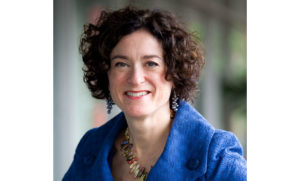From China to Mexico: Promoting Collaboration in the Earth and Space Sciences

AGU CEO/Executive Director Chris McEntee
In his post “Solidarity Among Scientists Across the Globe Is Needed Now More Than Ever” on From the Prow from 25 July 2018, AGU President Eric Davidson wrote that “we must stand together to insist that scientific collaboration remains international, and interdisciplinary.” It was so heartening to see support for his words during recent AGU leadership trips to China and Mexico. During these visits, our international colleagues and hosts agreed wholeheartedly with Eric’s words and expressed their ongoing commitment to preserving global scientific exchange and collaboration despite increasing calls of nationalism by political leaders in many countries around the world.
Here is a short recap of our various visits:
First stop: Qingdao where Margaret Leinen, AGU Past President; Chris McEntee, AGU Executive Director/CEO; Janice Lachance, AGU Executive Vice President, Strategic and Organizational Excellence, and Minghua Zhang, Editor in Chief of AGU’s publication, Journal of Geophysical Research-Atmospheres, met with colleagues from four institutions that are leaders in ocean sciences: the Institute of Oceanology of the Chinese Academy of Sciences, hosted by its director, Fan Wang; Qingdao National Laboratory for Marine Science and Technology, where AGU was hosted by its director, Lixin Wu; Ocean University of China, where AGU was hosted by its president, Zhigang Yu; and the First Institute of Oceanography, where AGU was hosted by its director general, Tiegang Li. At each meeting, we learned more about their research priorities, areas of expertise, how aquacultural research is helping to assure needed food supplies and new type of medicines for a growing Chinese and world population, as well as plans to create a “Blue Silicon Valley” to replicate for marine sciences and technology what the United States Silicon Valley has created for invention and entrepreneurship in the technology sector.
| news |
Second stop: Beijing, where Eric Davidson, AGU President, Chris McEntee, Janice Lachance, Brooks Hanson AGU Executive Vice President, Science, and Minghua Zhang and colleagues from Wiley Publishing held meetings with AGU scientific leaders, research universities, and key research directors from the Chinese Academy Sciences. At Beijing Normal University, Peking University, and the National Science Foundation of China, we learned more about how to better collaborate and partner with the research community in China, that publishing in AGU journals is of great interest to students and early career scientists, and that funders in China are very enthusiastic about working with AGU to help foster scientific exchange and collaboration. Dinner with key research directors from the Chinese Academy of Sciences was part brainstorming about future potential collaborations as well as celebrating the creation of the joint AGU- CAS Joint International Network in Geosciences meeting series (See below), an idea that was first proposed over dinner with many of those same leaders during an AGU leadership visit three years ago.
Stop 2.5: Eric Davidson stayed on in Beijing to participate in two events hosted by the China Institute of Water Resources and Hydropower Research: (1) A Round-Table Meeting of Leaders of Water-Related International Organizations, and (2) A Forum on Modern Water Governance and Technological Innovation. Scientists, engineers, and political leaders from Asia, Europe, Australia, and North and South America affirmed and re-emphasized the need for more attention to the cross-sectoral and interdisciplinary role of water in achieving the Sustainable Development Goals.
Third stop: Xi’an where Eric Davidson, Chris McEntee, Janice Lachance, Brooks Hanson, and Lauren Parr AGU’s Vice President of Meetings, participated and attended the first AGU-CAS J.I.N.G. meeting on the topic of PM 2.5. Co-chaired by Zhisheng An and Weijian Zhou of the Chinese Academy of Sciences and Judith Chow of the Desert Research Institute and James Hansen of Columbia University, the meeting presented cutting-edge research about the current state of PM 2.5 impacts upon the planet as well as novel ways to mitigate its impacts on human health and the environment. It is a very timely subject, attracting both senior researcher and students with nearly 600 individuals in attendance – double what had been anticipated by the meeting’s organizers.
Fourth stop: Puerto Vallarta, Mexico where Robin Bell, AGU President-elect, and Chris McEntee presented two of several plenary sessions at Reunion Annual de la Union Geofisica Mexicana 2018 that were organized to support AGU’s and International Union of Geodesy and Geophysics’ 100th anniversaries in 2019.
Although the meetings occurred in different parts of the globe and in different cultures ― as personified by the traditional Chinese dancing we enjoyed in Xi’an and a mariachi band in Mexico― the sentiment and themes from the scientific community were similar:
- The challenges faced by society require more transdisciplinary scientific collaboration than ever before.
- Despite the political leaders and ideologies in different countries, science can and should resist any temptation to close its borders to scientific exchange. We must stand united to assure that all of the planet and its various societies have the best scientific information upon which to base decision making and advance solutions.
- Despite differences in government funding in China and Mexico, the passion for science and the commitment by scientists to pursue their scientific work is shared by all, from students to senior researchers.
- AGU and other scientific societies are and will continue to add value by creating venues and increased opportunities for scientific exchange, dialogue and dissemination within and outside the Earth and space science community.






There are no comments
Add yours